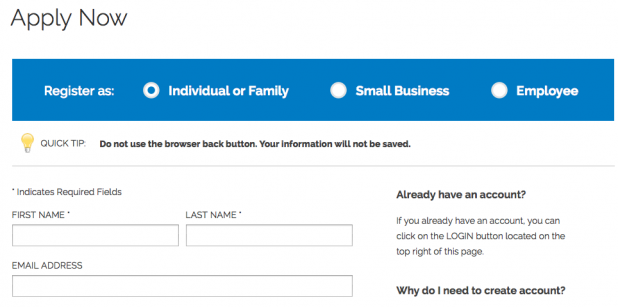 A lot of people have experienced trouble accessing even this screen.[/caption] In theory, the federal government’s Health Insurance Marketplace was supposed to make things easy for anyone in the market for health insurance. But fourteen days after the Website made its debut, the online initiative—an integral part of the Obama administration’s Affordable Care Act—has metastasized into a disaster. Despite costing $400 million (so far) and employing an army of experienced IT contractors (such as Booz Allen Hamilton and CGI Group), the Website is prone to glitches and frequent crashes, frustrating many of those seeking to sign up for a health-insurance policy. “The extent of the problems is pretty enormous,” an unnamed insurance executive told The New York Times, which interviewed dozens of contractors and officials who backed up that assessment. One of those anonymous sources estimated the Website and its underlying infrastructure at 70 percent complete, but had no idea when it would finally cross the finish line. Unless you’re the leader of a major federal agency or a huge company launching an online initiative targeted at millions of users, it’s unlikely you’ll ever wrestle with a project (and problems) on the scale of the Health Insurance Marketplace. Nonetheless, the debacle offers some handy lessons in project management for Websites and portals of any size:
A lot of people have experienced trouble accessing even this screen.[/caption] In theory, the federal government’s Health Insurance Marketplace was supposed to make things easy for anyone in the market for health insurance. But fourteen days after the Website made its debut, the online initiative—an integral part of the Obama administration’s Affordable Care Act—has metastasized into a disaster. Despite costing $400 million (so far) and employing an army of experienced IT contractors (such as Booz Allen Hamilton and CGI Group), the Website is prone to glitches and frequent crashes, frustrating many of those seeking to sign up for a health-insurance policy. “The extent of the problems is pretty enormous,” an unnamed insurance executive told The New York Times, which interviewed dozens of contractors and officials who backed up that assessment. One of those anonymous sources estimated the Website and its underlying infrastructure at 70 percent complete, but had no idea when it would finally cross the finish line. Unless you’re the leader of a major federal agency or a huge company launching an online initiative targeted at millions of users, it’s unlikely you’ll ever wrestle with a project (and problems) on the scale of the Health Insurance Marketplace. Nonetheless, the debacle offers some handy lessons in project management for Websites and portals of any size:
Lessons From the Feds’ Healthcare.gov Fiasco
[caption id="attachment_13110" align="aligncenter" width="618"]  A lot of people have experienced trouble accessing even this screen.[/caption] In theory, the federal government’s Health Insurance Marketplace was supposed to make things easy for anyone in the market for health insurance. But fourteen days after the Website made its debut, the online initiative—an integral part of the Obama administration’s Affordable Care Act—has metastasized into a disaster. Despite costing $400 million (so far) and employing an army of experienced IT contractors (such as Booz Allen Hamilton and CGI Group), the Website is prone to glitches and frequent crashes, frustrating many of those seeking to sign up for a health-insurance policy. “The extent of the problems is pretty enormous,” an unnamed insurance executive told The New York Times, which interviewed dozens of contractors and officials who backed up that assessment. One of those anonymous sources estimated the Website and its underlying infrastructure at 70 percent complete, but had no idea when it would finally cross the finish line. Unless you’re the leader of a major federal agency or a huge company launching an online initiative targeted at millions of users, it’s unlikely you’ll ever wrestle with a project (and problems) on the scale of the Health Insurance Marketplace. Nonetheless, the debacle offers some handy lessons in project management for Websites and portals of any size:
A lot of people have experienced trouble accessing even this screen.[/caption] In theory, the federal government’s Health Insurance Marketplace was supposed to make things easy for anyone in the market for health insurance. But fourteen days after the Website made its debut, the online initiative—an integral part of the Obama administration’s Affordable Care Act—has metastasized into a disaster. Despite costing $400 million (so far) and employing an army of experienced IT contractors (such as Booz Allen Hamilton and CGI Group), the Website is prone to glitches and frequent crashes, frustrating many of those seeking to sign up for a health-insurance policy. “The extent of the problems is pretty enormous,” an unnamed insurance executive told The New York Times, which interviewed dozens of contractors and officials who backed up that assessment. One of those anonymous sources estimated the Website and its underlying infrastructure at 70 percent complete, but had no idea when it would finally cross the finish line. Unless you’re the leader of a major federal agency or a huge company launching an online initiative targeted at millions of users, it’s unlikely you’ll ever wrestle with a project (and problems) on the scale of the Health Insurance Marketplace. Nonetheless, the debacle offers some handy lessons in project management for Websites and portals of any size:
 A lot of people have experienced trouble accessing even this screen.[/caption] In theory, the federal government’s Health Insurance Marketplace was supposed to make things easy for anyone in the market for health insurance. But fourteen days after the Website made its debut, the online initiative—an integral part of the Obama administration’s Affordable Care Act—has metastasized into a disaster. Despite costing $400 million (so far) and employing an army of experienced IT contractors (such as Booz Allen Hamilton and CGI Group), the Website is prone to glitches and frequent crashes, frustrating many of those seeking to sign up for a health-insurance policy. “The extent of the problems is pretty enormous,” an unnamed insurance executive told The New York Times, which interviewed dozens of contractors and officials who backed up that assessment. One of those anonymous sources estimated the Website and its underlying infrastructure at 70 percent complete, but had no idea when it would finally cross the finish line. Unless you’re the leader of a major federal agency or a huge company launching an online initiative targeted at millions of users, it’s unlikely you’ll ever wrestle with a project (and problems) on the scale of the Health Insurance Marketplace. Nonetheless, the debacle offers some handy lessons in project management for Websites and portals of any size:
A lot of people have experienced trouble accessing even this screen.[/caption] In theory, the federal government’s Health Insurance Marketplace was supposed to make things easy for anyone in the market for health insurance. But fourteen days after the Website made its debut, the online initiative—an integral part of the Obama administration’s Affordable Care Act—has metastasized into a disaster. Despite costing $400 million (so far) and employing an army of experienced IT contractors (such as Booz Allen Hamilton and CGI Group), the Website is prone to glitches and frequent crashes, frustrating many of those seeking to sign up for a health-insurance policy. “The extent of the problems is pretty enormous,” an unnamed insurance executive told The New York Times, which interviewed dozens of contractors and officials who backed up that assessment. One of those anonymous sources estimated the Website and its underlying infrastructure at 70 percent complete, but had no idea when it would finally cross the finish line. Unless you’re the leader of a major federal agency or a huge company launching an online initiative targeted at millions of users, it’s unlikely you’ll ever wrestle with a project (and problems) on the scale of the Health Insurance Marketplace. Nonetheless, the debacle offers some handy lessons in project management for Websites and portals of any size:
